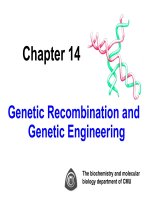Practical genetic engineering
Bạn đang xem bản rút gọn của tài liệu. Xem và tải ngay bản đầy đủ của tài liệu tại đây (412.67 KB, 15 trang )
MINISTRY OF EDUCATION AND TRAINING
CAN THO UNIVERSITY
BIOTECHNOLOGY RESEARCH AND DEVELOPMENT INSTITUTE
LAB REPORT
PRACTICAL GENETIC ENGINEERING
CODE: BT217
INSTRUCTOR
Pha, PhD.
GROUP 4
Class: Biotechnology (Advanced Program)
Course: 45
Can Tho, 11/2022
CONTENTS
LESSON 1: DNA EXTRACTION ............................................................................................................. 2
LESSON 2: TESTING DNA BY GEL ELECTROPHORESIS ............................................................. 4
LESSON 3: GENETIC DIVERSITY ANALYSIS OF RICE USING RAPD TECHNIQUE .............. 7
LESSON 4: GENETIC DIVERSITY ANALYSIS OF RICE USING SSR TECHNIQUE .................. 9
LESSON 5: INVESTIGATION OF EXON 1 REGION OF osHKT1;5 BY RESTRICTION
ENZYME ................................................................................................................................................... 12
1
LESSON 1
DNA EXTRACTION
1. PRINCIPLE
The principle of distinct solubility of distinct molecules (nucleic acid and protein)
in two insoluble phases (phenol, chloroform, and water) underpins DNA extraction.
The objective is to obtain nucleic acid molecules that have not been broken down
mechanically or chemically.
2. MANIPULATION
Step 1. Breaking cells open to release the DNA
Step 2. Separating DNA from proteins and other cellular debris
Step 3. Precipitating the DNA with an alcohol
Step 4. Cleaning the DNA
Step 5. Confirming the presence and quality of the DNA
3. MATERIALS
- Leaves from plant (young rice leaves)
- Mortar, cotton balls, scissors, clamps, type 2 mL Eppendorf, foil, marker, yellow
and cole, etc.
- Micropipettes (2-20 µL, 10-100 µL, 100-1000 µL)
- Water bath 65℃
- Centrifuges, moist heat sterilization pot, vacuum dryers, refrigerators -20℃.
- EB buffer: 0.1M Tris HCCL (pH 8), 0.5M NaCl, 0.05 EDTA, 0.01 beta- mercaptho
ethanol.
- TE buffer: 10 mM Tris pH 8 ,0.1 mM EDTA (pH 8).
- CTAB buffer: 0.2M Tris.Cl (pH 7,5), 2M NaCl, 0.05M EDTA, 2% (w/v) CTAB
(cetyltrimethylammonium bromide).
- SDS 10%, Ethanol 96% and 70%, Isopropanol.
- Mixed Chloroform - Isoamyl alcohol (24:1).
4.
-
PROTOCOL
Washing leaf with water and subsequently cleaning by alcohol.
Grounding the samples with 1 mL EB solution.
Taking out 1mL extracted solution and then transfer to tube 2.2 mL.
Adding 50 µl SDS 10% and mix well.
Incubating at 650C in 30 minutes
2
- Centrifuging at 13000 rpm in 10 minutes
- Taking out 800 µl upper solution, transferring to a new tube and adding 800 µl
isopropanol, shaking tube slightly
- Incubating at -200C in 2 hours
- Centrifuging at 13000 rpm in 10 minutes. Keeping precipitated part at the bottom
of the tube, removing the solution
- Adding to tube 400 µl TE 1X (pH 8), 400 µl CTAB buffer and incubating at 650C
in 15 minutes.
- Adding 800 µl Chloroform: Isoamyl alcohol solution at the ratio of 24:1 and shack
well
- Centrifuging at 13000 rpm in 5 minutes
- Transferring carefully 600 µl solution at phase 1 to another tube, adding 1.2 mL
ethanol 96% and incubating at room temperature in 15 minutes
- Centrifuging at 13000 rpm in 10 minutes, getting rid of the solution and keeping
- Drying tube with DNA by using vacuum at 450C in 10 minutes.
- Dissolving in 80 µl BiH2O to store DNA.
5. RESULT
-
Obtained DNA extracted from the leaves, then preserved for further experiments.
Notes on DNA extraction:
+ Plant leaf samples have an outer cellulose shell, should be chopped and crushed
to break the cellulose wall to easily obtain DNA.
+ SDS 10% (sodium dodecyl sulfate) and Ethanol 96% helps to break down cell
membranes and nuclear membranes.
+ Isopropanol is an alcohol used to precipitate DNA. The aim is to obtain nucleic
acids in concentrated form and protect them from enzymatic breakdown.
+ DNA was washed with 70% ethanol to remove salts and traces of isopropanol
(Since it is 30% water, NaCl will be dissolved).
+ CTAB 2% has a protein-precipitating effect but dissolves DNA and note the
temperature, if the temperature is too high it will denature the protein.
3
LESSON 2
TESTING DNA BY GEL ELECTROPHORESIS
1. INTRODUCTION
Electrophoresis is the process of dividing liquid molecules based on their
tendency to move in an electric field. Various types of electrophoresis, including DNA
or RNA, proteins, and polysaccharides, have emerged as the most important techniques
for investigating biomolecules in molecular biology and biochemistry.
Gel electrophoresis is a laboratory method used to separate mixtures of DNA,
RNA, or proteins according to molecular size, charge, or conformation. In gel
electrophoresis, the molecules to be separated are pushed by an electrical field through
a gel that contains small pores. Agarose is appropriate for separating DNA fragments
ranging in size from a few hundred base pairs to about 20 kb.
SafeView products represent a new and safe class of nucleic acid stains for the
visualization of double-stranded DNA, single-stranded DNA, and RNA in agarose
gels. The dyes are developed to replace toxic Ethidium Bromide (EB, a potent
mutagen), commonly used in gel electrophoresis for visualization of nucleic acids in
agarose gels. SafeView Classic is used the same way as Ethidium Bromide in agarose
gel electrophoresis. It emits green fluorescence when bound to dsDNA and red
fluorescence when bound to ssDNA or RNA. This stain has two fluorescence
excitation maxima when bound to nucleic acid, at approximately 290 nm and 490 nm.
2. MATERIALS
- Material: DNA sample and DNA ladder
- Chemical substances: agarose solutions, electrophoresis buffer (TBE 1X buffer),
loading buffer.
- Tools: gel casting trays, sample combs, an electrophoresis chamber and power
supply, micropipette, eppendorf, parafim paper, microwave, conical flask, Gel
documentation system.
3.
a.
-
PROTOCOL
Preparation agarose gel
Prepare 100 mL TBE 1X buffer and transfer the buffer to a conical flask.
Weigh 0.7 – 1 gram agarose and add to the conical flask containing 100 mL TBE
1X buffer.
4
- Melt completely the agarose solution in a microwave. And melted agarose should
be cooled to about 60℃. After that, add SafeView, shake and pour the solution to
the gel caster tray for solidification.
- Put the comb in the caster tray containing gel, after the gel has solidified, then
withdraw the comb.
b. Loading and running gel
- Place the gel in the electrophoresis tank. Add sufficient electrophoresis buffer to
cover the gel to depth of about 1mm (or just until the tops of the wells are
submerged). Make sure no air bubbles are trapped within the wells.
- DNA Ladders is pipetted into the first well.
- Sample containing 5 µL DNA mixed with 3 µL Loading buffer 6X by micropipette
and then pipetted into the sample wells.
- Connect the electrodes and switch on the current. Set the voltage of 50V to start
electrophoresis. Run the gel until the loading buffer dyes have moved an approriate
distance through the gel.
- Turn off the power suppy and then the gel tray may be removed and placed directly
on Gel documentation system to image and save.
4. RESULT AND DISCUSSION
a. Results
DNA extraction result
Marker
Marker
Figure 1: Small and large agarose gels after electrophoresis
Meaning
- The result of group 4 showed that in the small agarose gel.
- All samples were not contained DNA.
5
b.
Discussion
All samples were not contained DNA of the material. Due to the manipulation when
we proceed to extract DNA from the material was not standard such as:
- The samples were not mixed well enough with different chemicals, so the DNA was
not separated out of the tissue of the material.
- When we used the micropipette to take the sample from eppendorf, we did not shake
the tube carefully. Thus, we just took the water on the surface which is not contain
the DNA.
6
LESSON 3
GENETIC DIVERSITY ANALYSIS OF RICE
USING RAPD TECHNIQUE
1. PRINCIPLE
Short PCR primers with random sequences, typically between 8 and 15
nucleotides in length, are used in RAPD (randomly amplified polymorphic DNA)
marker analysis. These primers anneal randomLy at multiple sites on the genomic DNA
at a low annealing temperature, typically 35°C. As these random sequence primers
anneal to various regions of an organism's genome, complex patterns of PCR products
are produced. Due to the requirement of consistent PCR amplification conditions,
including thermal cycler ramp speeds, RAPD exhibits poor reproducibility across
laboratories. Consistently scoring electrophoretic images even in single-source samples
is difficult due to the complex patterns of RAPD, which also prevent mixture
interpretation.
A PCR-based method known as randomly amplified polymorphic DNA (RAPD)
makes use of arbitrary primers that bind to nonspecific DNA sites and amplify the
DNA. After being migrated on agarose gel, these amplified fragments exhibit a distinct
band pattern. The diversity study made use of this relatively straightforward and less
expensive method. However, this method has some drawbacks because the
amplification protocol must be very carefully designed to ensure the reproducibility of
the samples; Aside from that, the used DNA template needs to be properly purified
because PCR reactions may be stymied by contaminated samples.
2. MATERIALS
- Material: DNA template (lesson 1)
- Tools and chemical substances: Micropipette, Electrophoresis equipment minisub
gel, Gel reader Bio-Rad machine, Eppendorf tubes 1.5mL and 2mL, PCR machine,
Tris HCL (pH8), EDTA, agaroses, loading buffer 6X, RAPD primers.
3. PROTOCOL
- Prepare 1.5 mL eppendorf to contain the mixture which in turn will be separated to
many tubes for PCR to be carried out.
- Use micropipette to drag those chemical substances in the following table into 1.5
mL eppendorf respectively.
7
Table 1. Chemical substances mixture for RAPD technique (1 reaction)
Chemical substances
Volume (µl)
Bi.H2O
9,65
Buffer 5X
3
Primer RAPD
1,2
Taq polymerase
0,15
DNA
1
Total volume
15
-
-
After mixing up those compositions as table 1 (the number of reactions carry out by
each group). To separate the mixture into tubes 0.2 mL in such a way that each tube
contains 14 µL, then add 1 µL DNA sample to reach 15 µL.
Set program for PCR machine as the following thermal cycles:
Figure 2. Thermal cycle of PCR-RAPD
-
1.5% Agarose gel electrophoresis process steps:
Prepare a piece of paraffin to carry loading buffer, each droplet of loading buffer is
2 µL.
Use micropipette to drag 15 µL PCR-DNA product to mix well with a droplet of
loading buffer then put into gel wells
Pour TBE 1X into electrophoresis box after putting the gel on
Inject ladder solution on the first well
Operate the machine with 50V electric current
Pay attention the tracks of bands, do not let the color stain track run out of the gel.
8
LESSON 4
GENETIC DIVERSITY ANALYSIS OF RICE
USING SSR TECHNIQUE
1. PRINCIPLE
Microsatellites or simple sequence repeats (SSRs) are short repetitive elements
of 1- 6 bases that found in prokaryotic and all eukaryotic genomes. Dinucleotide
repeats like (CA)n and (GA)n are the most abundant repeats in most of the eukaryotes
(for e.g., in humans (CA)n repeat occurs once in every 30 kb). These repeat motifs,
which present in both coding and noncoding regions are smaller than 100bp.
Microsatellites are highly polymorphic, reproducible, abundant, inherited codominantly and distribute throughout genome. The excessive rate of mutation, high
number of alleles and frequency in the genomic DNA, have made SSRs very
effective molecular markers in population genetics, genome mapping, taxonomic
study, linkage analysis, genetic fingerprinting, and diversity. Generation of new
alleles and microsatellite instability can be related to several diseases. SSRs can be
amplified by the standard polymerase chain reaction (PCR), using specific primer
sequences from the flanking regions. This process of amplification and visualization
in agarose or denaturing polyacrylamide gel.
9
2. METARIALS
- DNA template (lesson 1)
- Tools and chemical substances: Micropipette, Electrophoresis equipment minisub
gel, gel reader Bio-Rad machine, Eppendorf tubes 1.5mL and 2mL, PCR machine,
agarose, loading buffer 6X, SSR primers.
3. PROTOCOL
- Prepare 1.5mL eppendorf to contain the mixture which in turn will be
separated to many tubes for PCR to be carried out.
- Use micropipette to drag those chemical substances in the following table into
2 mL eppendorf respectively.
Table 2. Chemical substances mixture for SSR technique (1 reaction)
Volume (µL)
8.65
Chemical substances
Bi.H2O
Buffer 5X
Primer R
Primer F
Taq polymerase
DNA
Total volume
3
0.6
0.6
0.15
2
15
-
After mixing up those compositions as table 1 (the number of reactions carry
out by each group). To separate the mixture into tubes 0.2 mL in such a way
that each tube contains 13 µL, then add 2 µL DNA sample to reach 15 µL.
- Set program for PCR machine as the following thermal cycles:
PCR product was run on 1.5% agarose gel electrophoresis in TBE buffer 1X for 20
minutes under 100V and take gel pictures with Bio-Rad UV gel camera.
10
94oC
5:00
94oC
0:25
46oC
72oC
72oC
0:25
3:00
0:25
4oC
30 cycles
Figure 3: Thermal cycle of PCR-SSR
4. RESULT AND DISCUSSION
Figure 4. Electrophoresis product of the SSR technique was performed on 1.5%
agarose gels in TBE buffer 1X for 15 minutes at 100 volts while taking gel images
with a Bio-Rad UV gel camera.
From well 13 to well 16, Electrophoresis results show that primer can
amplifies all samples of the group with 1 clear monomorphic band, 3 to 4 fuzzy and
blurred bands. The cause could be:
- Due to an error in the micropipette (non-standard volume) resulting in too much
template was added, primer concentration was too high
- Thermal cycler was not at correct temperature, need to calibrate the thermal cycler
or use a different machine.
11
LESSON 5
INVESTIGATION OF EXON 1 REGION OF osHKT1;5
BY RESTRICTION ENZYME
1. INTRODUCTION
Numerous studies that have been done on the mechanism of rice's salinity
tolerance have revealed that it is a complex mechanism governed by numerous genes.
Na+ and K+ channels related to salinity tolerance play a significant role in the
mechanisms by which plants resist stress. The protein HKT (High-Affinity K +
Transporter) is crucial for maintaining ion balance in cells, according to research on
ion balance in plants. Numerous genes, including OsHKT1; 2, OsHKT2; 3, OsHKT1;
1, OsHKT1; 4, and OsHKT1; 5, are members of this gene family (Waters et al., 2013;
Hama-moto et al., 2015). The key to rice's ability to withstand salinity is the role that
OsHKT1; 5 plays in encoding ion Na+ transport proteins from roots to shoots.
OsHKT1;5 is at about 4.487 bp long, with a coding region that requires 1665 bp to
encode 555 amino acids.
Figure 5. Map of osHKT1;5 gene
2. MATERIALS
- DNA template (lesson 1)
- Tools and chemical substances: Micropipette, Electrophoresis equipment minisub
gel, gel reader Bio-Rad machine, Eppendorf tubes 1.5 mL and 2 mL, PCR
machine, agarose, loading buffer 6X.
- Primers for exon 1 (F- 5’GGACCTGATCTTCACGTCGG3’ and R5’GAGCACCATCTCACCGGAG3’). Amplifier product length is 1000 bp.
3. PROTOCOL
- Prepare 1.5 mL ependorf to contain the mixture which in turn will be separated to
many tubes for PCR to be carried out.
- Use micropipette to drag those chemical substances in the following table into 1.5
mL ependorf respectively.
12
Table 3. Chemical substances mixture for PCR osHKT1;5 (1 reaction)
Chemical substances
Volume (μL)
Bi.H2O
15.75
Buffer 5X
5
Primer R (osHKT1;5)
1
Primer F (osHKT1;5)
1
Taq polymerase
0.25
DNA
2
Total volume
25
-
-
-
After mixing up those compositions as table 3 (the number of reactions carry out by
each group). To separate the mixture into tubes 0.2 mL in such a way that each tube
contains 14 μL, then add 1 μL DNA sample to reach 15 μL
Set program for PCR machine as the following thermal cycles: 95°C for 2 min of
pre-denaturation, 30 cycle of (94°C for 30s, Tm 58℃ for 30s, 72°C for 45s), 72°C
for 5 min of prolonged extension step.
PCR product was run on 1.5% agarose gel electrophoresis in TBE buffer 1X for 20
min under 100V and take gel pictures with Bio-Rad UV gel camera.
RE reaction
- Prepare 1.5mL ependorf to contain the mixture which in turn will be seperated to
many tubes for RE reaction
- Use micropipette to drag those chemical substances in the following table into 1.5
mL ependorf respectively.
Table 4. Chemical substances mixture for RE reaction (1 reaction)
Chemical substances
Volume (μL)
Bi.H2O
4.5
Buffer 10X
1.5
RE
1
PCR-product
8
Total volume
15
- After mixing up those compositions as table 4 (the number of reactions carry out by
each group). To separate the mixture into tubes 1.5 mL in such a way that each tube
contains 7 μL, then add 8 μL DNA (PCR-product) sample to reach 15 μL.
- The RE reaction was incubated in suitable temperature.
- RE reaction product was ran on 1.5% agarose gel electrophoresis in TBE buffer 1X
13
for 40 mins under 50V and take gel pictures with Bio-Rad UV gel camera.
4. RESULT AND DISCUSSION
The result showed in agarose gel with all sample contained DNA and appear two
bands of DNA.
Two DNA bands were visible on the gel electrophoresis because of restriction
enzymes that cleave the original DNA into two fragments with different molecular
sizes. In Figure 6, Smaller DNA molecules can move through gel electrophoresis more
quickly and farther (lower band). Large DNA molecules will move slowly and not very
far on the gel electrophoresis (the upper band is above).
Large molecule DNA
Small molecule DNA
Figure 6. Electrophoresis of the RE reaction product was performed on 1.5%
agarose gels in TBE buffer 1X for 30 minutes at 50 volts while taking gel images
with a Bio-Rad UV gel camera.
14









